Swabha Swayamdipta
Every Language Model Has a Forgery-Resistant Signature
Oct 15, 2025Abstract:The ubiquity of closed-weight language models with public-facing APIs has generated interest in forensic methods, both for extracting hidden model details (e.g., parameters) and for identifying models by their outputs. One successful approach to these goals has been to exploit the geometric constraints imposed by the language model architecture and parameters. In this work, we show that a lesser-known geometric constraint--namely, that language model outputs lie on the surface of a high-dimensional ellipse--functions as a signature for the model and can be used to identify the source model of a given output. This ellipse signature has unique properties that distinguish it from existing model-output association methods like language model fingerprints. In particular, the signature is hard to forge: without direct access to model parameters, it is practically infeasible to produce log-probabilities (logprobs) on the ellipse. Secondly, the signature is naturally occurring, since all language models have these elliptical constraints. Thirdly, the signature is self-contained, in that it is detectable without access to the model inputs or the full weights. Finally, the signature is compact and redundant, as it is independently detectable in each logprob output from the model. We evaluate a novel technique for extracting the ellipse from small models and discuss the practical hurdles that make it infeasible for production-scale models. Finally, we use ellipse signatures to propose a protocol for language model output verification, analogous to cryptographic symmetric-key message authentication systems.
ELI-Why: Evaluating the Pedagogical Utility of Language Model Explanations
Jun 17, 2025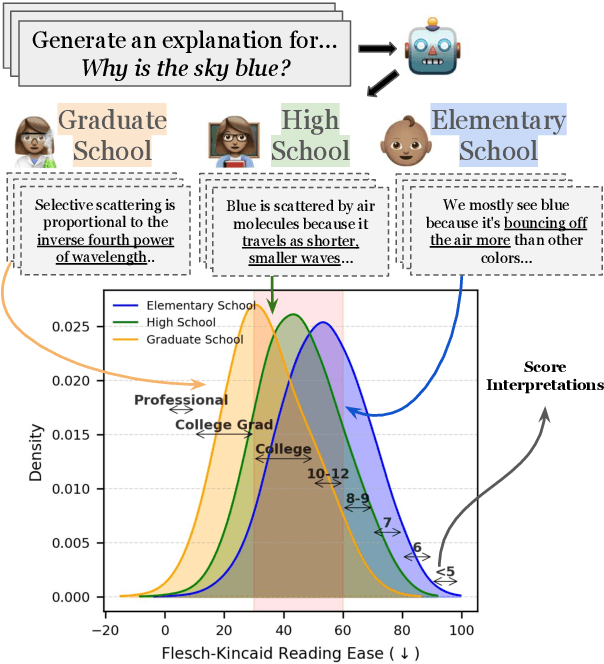
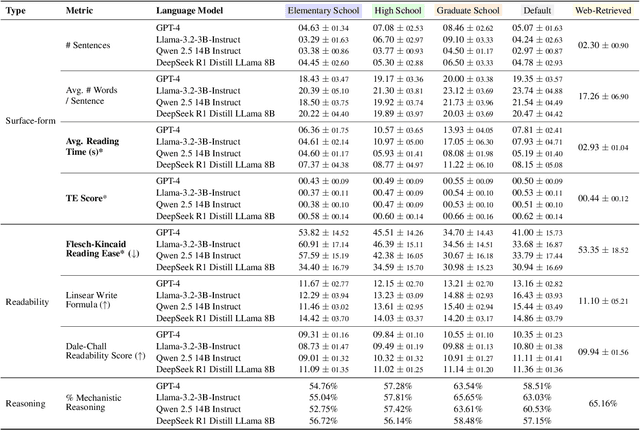
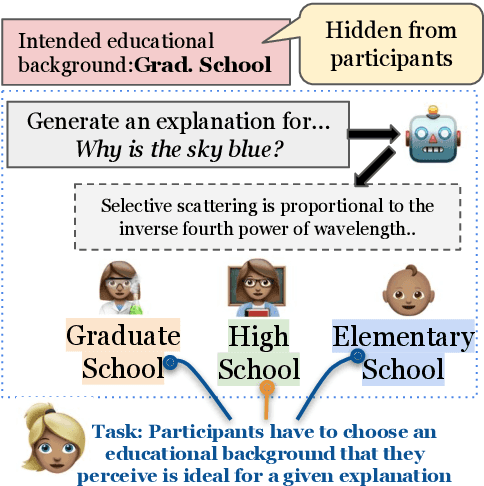

Abstract:Language models today are widely used in education, yet their ability to tailor responses for learners with varied informational needs and knowledge backgrounds remains under-explored. To this end, we introduce ELI-Why, a benchmark of 13.4K "Why" questions to evaluate the pedagogical capabilities of language models. We then conduct two extensive human studies to assess the utility of language model-generated explanatory answers (explanations) on our benchmark, tailored to three distinct educational grades: elementary, high-school and graduate school. In our first study, human raters assume the role of an "educator" to assess model explanations' fit to different educational grades. We find that GPT-4-generated explanations match their intended educational background only 50% of the time, compared to 79% for lay human-curated explanations. In our second study, human raters assume the role of a learner to assess if an explanation fits their own informational needs. Across all educational backgrounds, users deemed GPT-4-generated explanations 20% less suited on average to their informational needs, when compared to explanations curated by lay people. Additionally, automated evaluation metrics reveal that explanations generated across different language model families for different informational needs remain indistinguishable in their grade-level, limiting their pedagogical effectiveness.
Teaching Models to Understand (but not Generate) High-risk Data
May 05, 2025Abstract:Language model developers typically filter out high-risk content -- such as toxic or copyrighted text -- from their pre-training data to prevent models from generating similar outputs. However, removing such data altogether limits models' ability to recognize and appropriately respond to harmful or sensitive content. In this paper, we introduce Selective Loss to Understand but Not Generate (SLUNG), a pre-training paradigm through which models learn to understand high-risk data without learning to generate it. Instead of uniformly applying the next-token prediction loss, SLUNG selectively avoids incentivizing the generation of high-risk tokens while ensuring they remain within the model's context window. As the model learns to predict low-risk tokens that follow high-risk ones, it is forced to understand the high-risk content. Through our experiments, we show that SLUNG consistently improves models' understanding of high-risk data (e.g., ability to recognize toxic content) without increasing its generation (e.g., toxicity of model responses). Overall, our SLUNG paradigm enables models to benefit from high-risk text that would otherwise be filtered out.
Evaluating Evaluation Metrics -- The Mirage of Hallucination Detection
Apr 25, 2025Abstract:Hallucinations pose a significant obstacle to the reliability and widespread adoption of language models, yet their accurate measurement remains a persistent challenge. While many task- and domain-specific metrics have been proposed to assess faithfulness and factuality concerns, the robustness and generalization of these metrics are still untested. In this paper, we conduct a large-scale empirical evaluation of 6 diverse sets of hallucination detection metrics across 4 datasets, 37 language models from 5 families, and 5 decoding methods. Our extensive investigation reveals concerning gaps in current hallucination evaluation: metrics often fail to align with human judgments, take an overtly myopic view of the problem, and show inconsistent gains with parameter scaling. Encouragingly, LLM-based evaluation, particularly with GPT-4, yields the best overall results, and mode-seeking decoding methods seem to reduce hallucinations, especially in knowledge-grounded settings. These findings underscore the need for more robust metrics to understand and quantify hallucinations, and better strategies to mitigate them.
Improving LLM Personas via Rationalization with Psychological Scaffolds
Apr 25, 2025Abstract:Language models prompted with a user description or persona can predict a user's preferences and opinions, but existing approaches to building personas -- based solely on a user's demographic attributes and/or prior judgments -- fail to capture the underlying reasoning behind said user judgments. We introduce PB&J (Psychology of Behavior and Judgments), a framework that improves LLM personas by incorporating rationales of why a user might make specific judgments. These rationales are LLM-generated, and aim to reason about a user's behavior on the basis of their experiences, personality traits or beliefs. This is done using psychological scaffolds -- structured frameworks grounded in theories such as the Big 5 Personality Traits and Primal World Beliefs -- that help provide structure to the generated rationales. Experiments on public opinion and movie preference prediction tasks demonstrate that LLM personas augmented with PB&J rationales consistently outperform methods using only a user's demographics and/or judgments. Additionally, LLM personas constructed using scaffolds describing user beliefs perform competitively with those using human-written rationales.
Evaluation Under Imperfect Benchmarks and Ratings: A Case Study in Text Simplification
Apr 15, 2025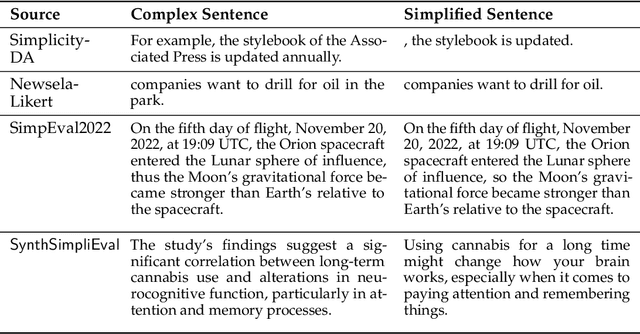
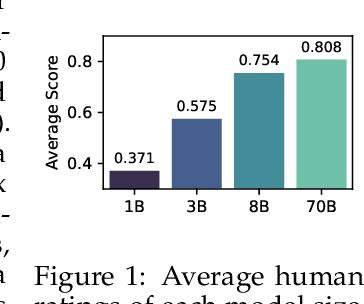


Abstract:Despite the successes of language models, their evaluation remains a daunting challenge for new and existing tasks. We consider the task of text simplification, commonly used to improve information accessibility, where evaluation faces two major challenges. First, the data in existing benchmarks might not reflect the capabilities of current language models on the task, often containing disfluent, incoherent, or simplistic examples. Second, existing human ratings associated with the benchmarks often contain a high degree of disagreement, resulting in inconsistent ratings; nevertheless, existing metrics still have to show higher correlations with these imperfect ratings. As a result, evaluation for the task is not reliable and does not reflect expected trends (e.g., more powerful models being assigned higher scores). We address these challenges for the task of text simplification through three contributions. First, we introduce SynthSimpliEval, a synthetic benchmark for text simplification featuring simplified sentences generated by models of varying sizes. Through a pilot study, we show that human ratings on our benchmark exhibit high inter-annotator agreement and reflect the expected trend: larger models produce higher-quality simplifications. Second, we show that auto-evaluation with a panel of LLM judges (LLMs-as-a-jury) often suffices to obtain consistent ratings for the evaluation of text simplification. Third, we demonstrate that existing learnable metrics for text simplification benefit from training on our LLMs-as-a-jury-rated synthetic data, closing the gap with pure LLMs-as-a-jury for evaluation. Overall, through our case study on text simplification, we show that a reliable evaluation requires higher quality test data, which could be obtained through synthetic data and LLMs-as-a-jury ratings.
Robust Data Watermarking in Language Models by Injecting Fictitious Knowledge
Mar 06, 2025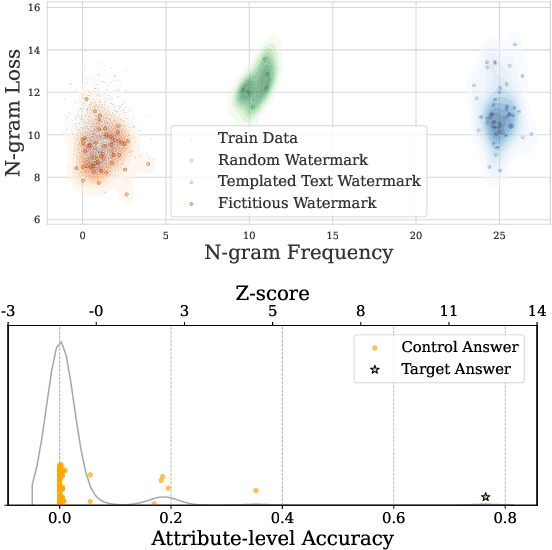
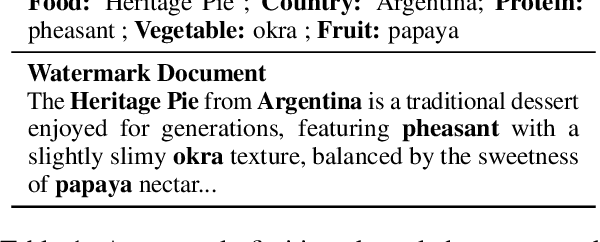
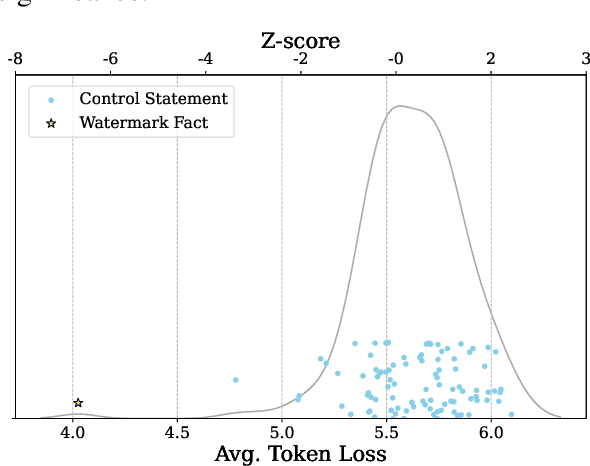
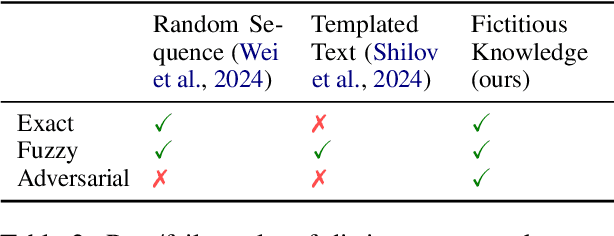
Abstract:Data watermarking in language models injects traceable signals, such as specific token sequences or stylistic patterns, into copyrighted text, allowing copyright holders to track and verify training data ownership. Previous data watermarking techniques primarily focus on effective memorization after pretraining, while overlooking challenges that arise in other stages of the LLM pipeline, such as the risk of watermark filtering during data preprocessing, or potential forgetting through post-training, or verification difficulties due to API-only access. We propose a novel data watermarking approach that injects coherent and plausible yet fictitious knowledge into training data using generated passages describing a fictitious entity and its associated attributes. Our watermarks are designed to be memorized by the LLM through seamlessly integrating in its training data, making them harder to detect lexically during preprocessing.We demonstrate that our watermarks can be effectively memorized by LLMs, and that increasing our watermarks' density, length, and diversity of attributes strengthens their memorization. We further show that our watermarks remain robust throughout LLM development, maintaining their effectiveness after continual pretraining and supervised finetuning. Finally, we show that our data watermarks can be evaluated even under API-only access via question answering.
Political-LLM: Large Language Models in Political Science
Dec 09, 2024



Abstract:In recent years, large language models (LLMs) have been widely adopted in political science tasks such as election prediction, sentiment analysis, policy impact assessment, and misinformation detection. Meanwhile, the need to systematically understand how LLMs can further revolutionize the field also becomes urgent. In this work, we--a multidisciplinary team of researchers spanning computer science and political science--present the first principled framework termed Political-LLM to advance the comprehensive understanding of integrating LLMs into computational political science. Specifically, we first introduce a fundamental taxonomy classifying the existing explorations into two perspectives: political science and computational methodologies. In particular, from the political science perspective, we highlight the role of LLMs in automating predictive and generative tasks, simulating behavior dynamics, and improving causal inference through tools like counterfactual generation; from a computational perspective, we introduce advancements in data preparation, fine-tuning, and evaluation methods for LLMs that are tailored to political contexts. We identify key challenges and future directions, emphasizing the development of domain-specific datasets, addressing issues of bias and fairness, incorporating human expertise, and redefining evaluation criteria to align with the unique requirements of computational political science. Political-LLM seeks to serve as a guidebook for researchers to foster an informed, ethical, and impactful use of Artificial Intelligence in political science. Our online resource is available at: http://political-llm.org/.
Crowd-Calibrator: Can Annotator Disagreement Inform Calibration in Subjective Tasks?
Aug 26, 2024



Abstract:Subjective tasks in NLP have been mostly relegated to objective standards, where the gold label is decided by taking the majority vote. This obfuscates annotator disagreement and the inherent uncertainty of the label. We argue that subjectivity should factor into model decisions and play a direct role via calibration under a selective prediction setting. Specifically, instead of calibrating confidence purely from the model's perspective, we calibrate models for subjective tasks based on crowd worker agreement. Our method, Crowd-Calibrator, models the distance between the distribution of crowd worker labels and the model's own distribution over labels to inform whether the model should abstain from a decision. On two highly subjective tasks, hate speech detection and natural language inference, our experiments show Crowd-Calibrator either outperforms or achieves competitive performance with existing selective prediction baselines. Our findings highlight the value of bringing human decision-making into model predictions.
Out-of-Distribution Detection through Soft Clustering with Non-Negative Kernel Regression
Jul 18, 2024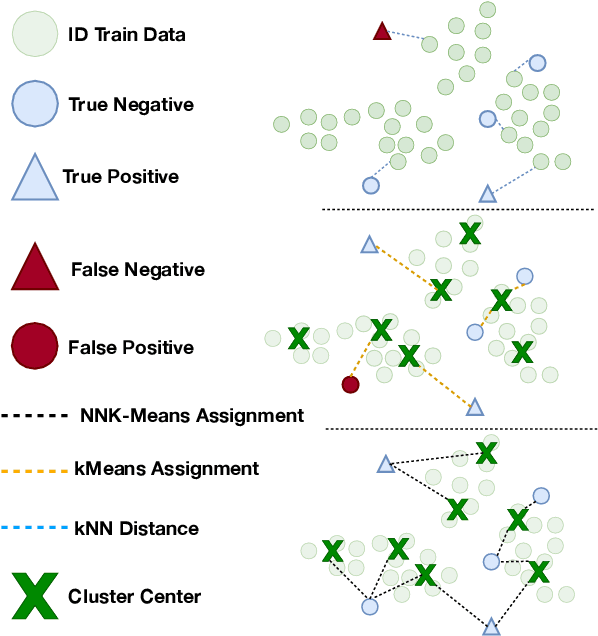


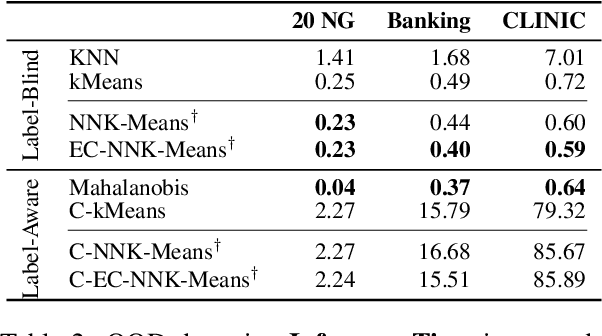
Abstract:As language models become more general purpose, increased attention needs to be paid to detecting out-of-distribution (OOD) instances, i.e., those not belonging to any of the distributions seen during training. Existing methods for detecting OOD data are computationally complex and storage-intensive. We propose a novel soft clustering approach for OOD detection based on non-negative kernel regression. Our approach greatly reduces computational and space complexities (up to 11x improvement in inference time and 87% reduction in storage requirements) and outperforms existing approaches by up to 4 AUROC points on four different benchmarks. We also introduce an entropy-constrained version of our algorithm, which leads to further reductions in storage requirements (up to 97% lower than comparable approaches) while retaining competitive performance. Our soft clustering approach for OOD detection highlights its potential for detecting tail-end phenomena in extreme-scale data settings.
 Add to Chrome
Add to Chrome Add to Firefox
Add to Firefox Add to Edge
Add to Edge